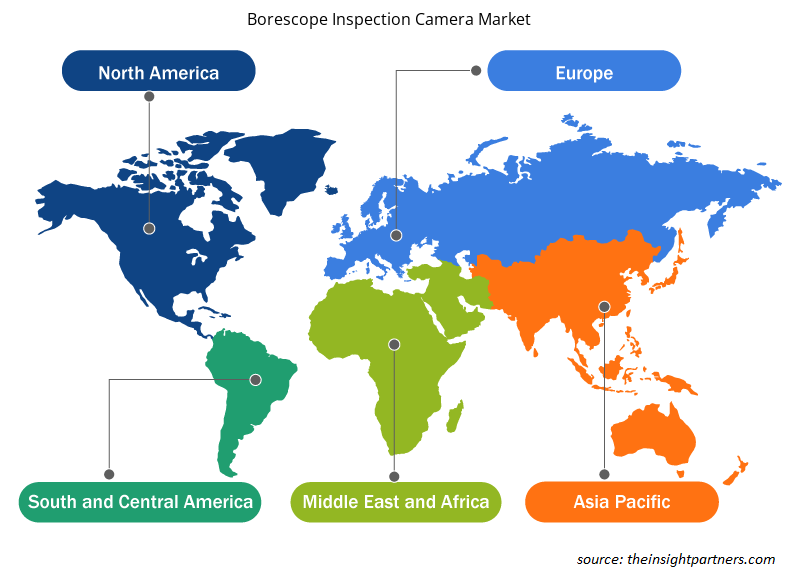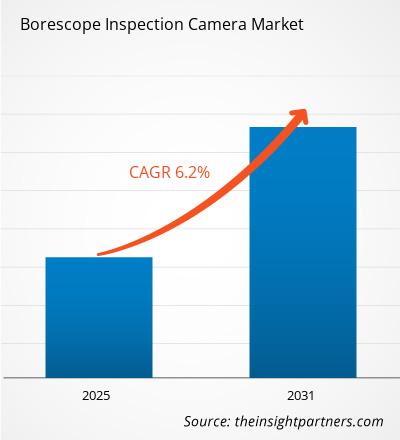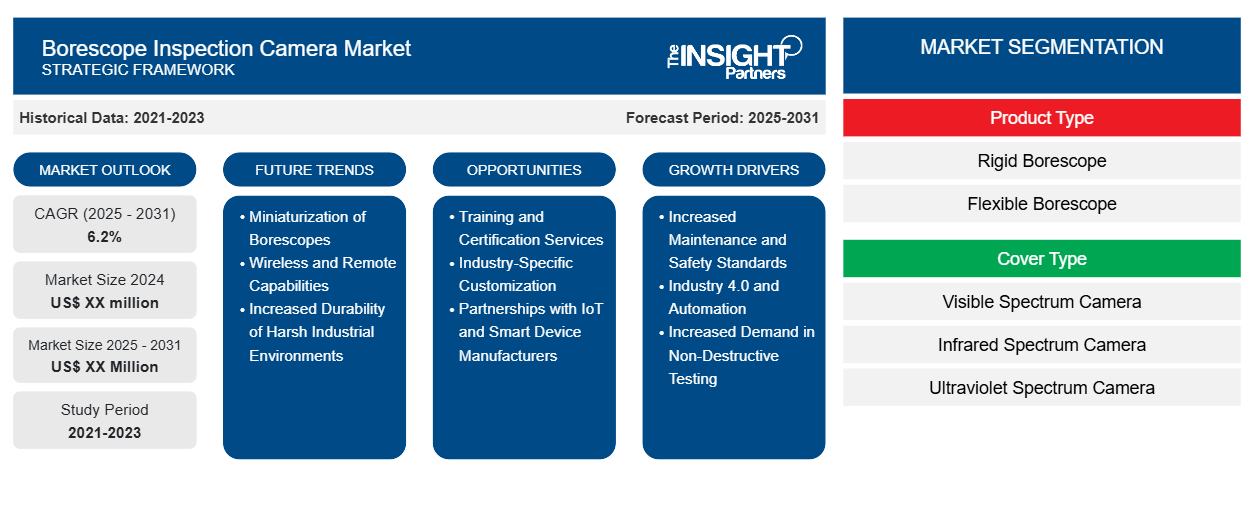Se espera que el mercado de cámaras de inspección con boroscopio registre una CAGR del 6,2 % entre 2023 y 2031, con un tamaño de mercado que se expandirá de US$ XX millones en 2023 a US$ XX millones en 2031.
El informe está segmentado por tipo de producto (boroscopio rígido, boroscopio flexible). El informe presenta además un análisis basado en el tipo de cubierta (cámara de espectro visible, cámara de espectro infrarrojo, cámara de espectro ultravioleta). Además, está segmentado en función de la aplicación (industria del embalaje, industria farmacéutica, industria automotriz, industria eléctrica, otras). El análisis global se desglosa aún más a nivel regional y por países principales. El informe ofrece el valor en USD para el análisis y los segmentos anteriores.
Propósito del Informe
El informe Borescope Inspection Camera Market de The Insight Partners tiene como objetivo describir el panorama actual y el crecimiento futuro, los principales factores impulsores, los desafíos y las oportunidades. Esto proporcionará información a diversas partes interesadas del negocio, como:
- Proveedores/fabricantes de tecnología: Para comprender la dinámica cambiante del mercado y conocer las oportunidades potenciales de crecimiento, lo que les permitirá tomar decisiones estratégicas informadas.
- Inversionistas: Realizar un análisis exhaustivo de tendencias sobre la tasa de crecimiento del mercado, las proyecciones financieras del mercado y las oportunidades que existen en toda la cadena de valor.
- Órganos reguladores: Regular las políticas y vigilar las actividades del mercado con el objetivo de minimizar los abusos, preservar la confianza de los inversores y defender la integridad y estabilidad del mercado.
Segmentación del mercado de cámaras de inspección con boroscopio
Tipo de producto
- Boroscopio rígido
- Boroscopio flexible
Tipo de cubierta
- Cámara de espectro visible
- Cámara de espectro infrarrojo
- Cámara de espectro ultravioleta
Solicitud
- Industria del embalaje
- Industria farmacéutica
- Industria automotriz
- Industria eléctrica
- Otros
Geografía
- América del norte
- Europa
- Asia-Pacífico
- América del Sur y Central
- Oriente Medio y África
Geografía
- América del norte
- Europa
- Asia-Pacífico
- América del Sur y Central
- Oriente Medio y África
Personalice este informe según sus necesidades
Obtendrá personalización en cualquier informe, sin cargo, incluidas partes de este informe o análisis a nivel de país, paquete de datos de Excel, así como también grandes ofertas y descuentos para empresas emergentes y universidades.
-
Obtenga las principales tendencias clave del mercado de este informe.Esta muestra GRATUITA incluirá análisis de datos, desde tendencias del mercado hasta estimaciones y pronósticos.
Factores impulsores del crecimiento del mercado de cámaras de inspección con boroscopio
- Mayores estándares de seguridad y mantenimiento: las estrictas normas de seguridad y mantenimiento en las industrias, especialmente en los sectores de energía, petróleo y gas, impulsan la demanda de herramientas de inspección sofisticadas, como los boroscopios. Estos dispositivos ayudan a garantizar un control seguro, eficiente y preciso del estado de la infraestructura y los equipos.
- Industria 4.0 y automatización: la integración de cámaras de inspección con boroscopio con sistemas de fabricación inteligente y las iniciativas de la Industria 4.0 en monitoreo en tiempo real, mantenimiento predictivo y diagnóstico automatizado respaldan la demanda de tecnologías avanzadas para inspección, impulsando así este mercado.
- Mayor demanda de pruebas no destructivas: los sectores aeroespacial, automotriz y energético, entre otros, utilizan cada vez más cámaras de inspección con boroscopio para realizar pruebas no destructivas. Esta cámara permite realizar inspecciones interiores de los equipos sin desmontarlos, lo que reduce el tiempo de inactividad y aumenta la eficiencia del mantenimiento para impulsar el crecimiento del mercado.
Tendencias futuras del mercado de cámaras de inspección con boroscopio
- Miniaturización de los boroscopios: Los diseños más pequeños y compactos de boroscopios están ganando popularidad, lo que les permite acceder a espacios más reducidos. Las versiones miniaturizadas son muy prácticas, portátiles, fáciles de usar y más precisas, lo que es muy valorado en industrias como la aeroespacial y la electrónica para inspecciones en áreas confinadas.
- Capacidades inalámbricas y remotas: el mercado está experimentando con cámaras boroscopio que ofrecen capacidades inalámbricas e inspección remota. Esto permite a los técnicos ver las inspecciones internas en tiempo real, pero desde ubicaciones distantes, por lo que esta tendencia mejora la comodidad y permite una toma de decisiones rápida, especialmente en entornos peligrosos.
- Mayor durabilidad en entornos industriales hostiles: se han diseñado boroscopios robustos, resistentes a la corrosión y al calor para plataformas petrolíferas, plantas de energía e instalaciones de fabricación como parte de la tendencia clave. La alta confiabilidad en condiciones extremas requiere un avance en los materiales, lo que impulsa la demanda del mercado.
Oportunidades de mercado de cámaras de inspección con boroscopio
- Servicios de capacitación y certificación: con el desarrollo de cámaras de inspección con boroscopio de alta tecnología, ahora también se necesita capacitación para garantizar un uso adecuado. El mercado se puede abordar mediante cursos de certificación o paquetes de capacitación para avanzar en la aplicación de dichas tecnologías en industrias especializadas.
- Personalización específica para cada sector: las empresas pueden crear cámaras de inspección con boroscopio altamente especializadas para sectores muy específicos, como en el caso de la industria aeroespacial, que requiere cámaras de muy alta resolución, o la industria del petróleo y el gas, que requiere diseños a prueba de explosiones. Las soluciones personalizadas abren caminos para un gran crecimiento en nichos de mercado.
- Asociaciones con fabricantes de IoT y dispositivos inteligentes: la colaboración de los fabricantes de boroscopios con empresas de IoT/tecnología para integrar cámaras de inspección con dispositivos inteligentes es una oportunidad para el desarrollo de soluciones de monitoreo conectadas y en tiempo real que pueden resultar atractivas para industrias enfocadas en el mantenimiento predictivo y organizaciones operativas óptimas.
Perspectivas regionales del mercado de cámaras de inspección con boroscopio
Los analistas de Insight Partners explicaron en detalle las tendencias y los factores regionales que influyen en el mercado de cámaras de inspección por boroscopio durante el período de pronóstico. Esta sección también analiza los segmentos y la geografía del mercado de cámaras de inspección por boroscopio en América del Norte, Europa, Asia Pacífico, Oriente Medio y África, y América del Sur y Central.

- Obtenga datos regionales específicos para el mercado de cámaras de inspección con boroscopio
Alcance del informe de mercado de cámaras de inspección con boroscopio
| Atributo del informe | Detalles |
|---|---|
| Tamaño del mercado en 2023 | XX millones de dólares estadounidenses |
| Tamaño del mercado en 2031 | US$ XX millones |
| CAGR global (2023 - 2031) | 6,2% |
| Datos históricos | 2021-2022 |
| Período de pronóstico | 2024-2031 |
| Segmentos cubiertos |
Por tipo de producto
|
| Regiones y países cubiertos |
América del norte
|
| Líderes del mercado y perfiles de empresas clave |
|
Densidad de actores del mercado de cámaras de inspección con boroscopio: comprensión de su impacto en la dinámica empresarial
El mercado de cámaras de inspección con boroscopio está creciendo rápidamente, impulsado por la creciente demanda de los usuarios finales debido a factores como la evolución de las preferencias de los consumidores, los avances tecnológicos y una mayor conciencia de los beneficios del producto. A medida que aumenta la demanda, las empresas amplían sus ofertas, innovan para satisfacer las necesidades de los consumidores y aprovechan las tendencias emergentes, lo que impulsa aún más el crecimiento del mercado.
La densidad de actores del mercado se refiere a la distribución de las empresas o firmas que operan dentro de un mercado o industria en particular. Indica cuántos competidores (actores del mercado) están presentes en un espacio de mercado determinado en relación con su tamaño o valor total de mercado.
Las principales empresas que operan en el mercado de cámaras de inspección con boroscopio son:
- Corporación Cognex
- Corporación Olympus
- Herramienta Milwaukee
- AMETEK
- Corporación Fluke
Descargo de responsabilidad : Las empresas enumeradas anteriormente no están clasificadas en ningún orden particular.

- Obtenga una descripción general de los principales actores clave del mercado de cámaras de inspección por boroscopio
Puntos de venta clave
- Cobertura integral: el informe cubre de manera integral el análisis de productos, servicios, tipos y usuarios finales del mercado de cámaras de inspección de boroscopio, proporcionando un panorama holístico.
- Análisis de expertos: el informe se compila sobre la base de un profundo conocimiento de expertos y analistas de la industria.
- Información actualizada: El informe asegura relevancia comercial debido a su cobertura de información reciente y tendencias de datos.
- Opciones de personalización: este informe se puede personalizar para satisfacer los requisitos específicos del cliente y adaptarse adecuadamente a las estrategias comerciales.
Por lo tanto, el informe de investigación sobre el mercado de cámaras de inspección con boroscopio puede ayudar a abrir el camino para descifrar y comprender el escenario de la industria y las perspectivas de crecimiento. Si bien puede haber algunas preocupaciones válidas, los beneficios generales de este informe tienden a superar las desventajas.
- Análisis histórico (2 años), año base, pronóstico (7 años) con CAGR
- Análisis PEST y FODA
- Tamaño del mercado, valor/volumen: global, regional y nacional
- Industria y panorama competitivo
- Conjunto de datos de Excel
Informes recientes
Informes relacionados
Testimonios
Razón para comprar
- Toma de decisiones informada
- Comprensión de la dinámica del mercado
- Análisis competitivo
- Información sobre clientes
- Pronósticos del mercado
- Mitigación de riesgos
- Planificación estratégica
- Justificación de la inversión
- Identificación de mercados emergentes
- Mejora de las estrategias de marketing
- Impulso de la eficiencia operativa
- Alineación con las tendencias regulatorias























 Obtenga una muestra gratuita para - Mercado de cámaras de inspección con boroscopio
Obtenga una muestra gratuita para - Mercado de cámaras de inspección con boroscopio